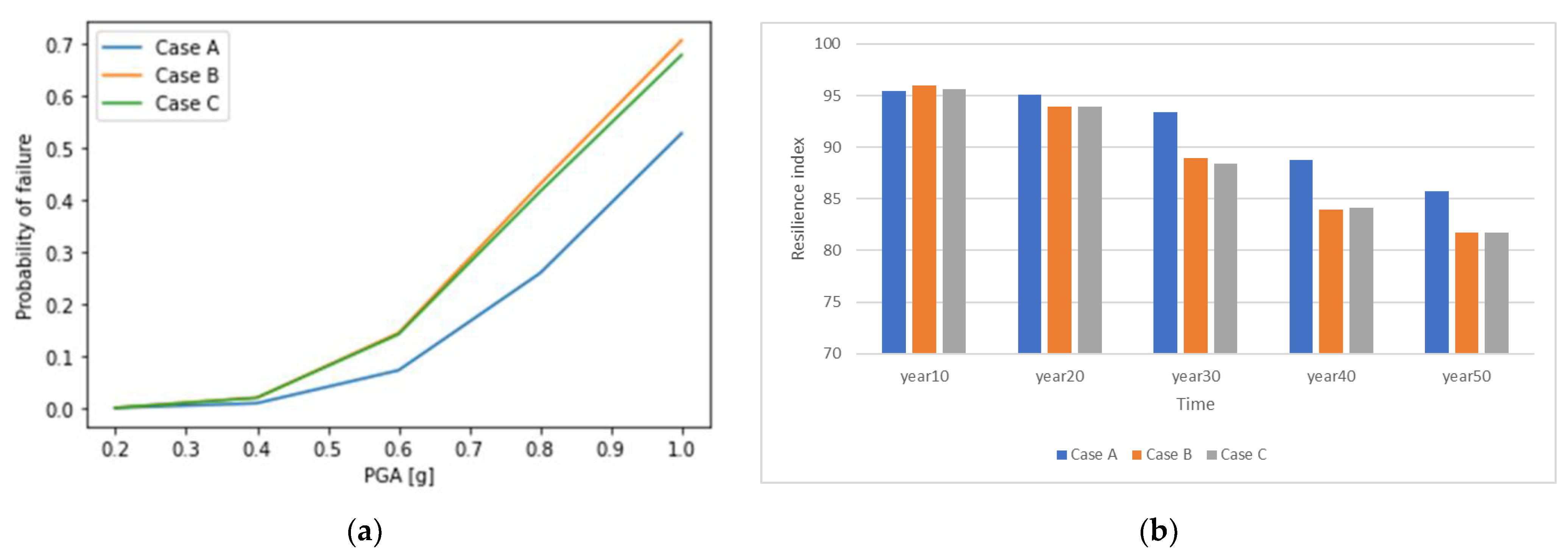Quantifying and Reducing Uncertainty in Transportation System Resilience Assessment: A Dynamic Bayesian Network Approach †
Abstract
1. Introduction
2. Methodology
3. Benchmark Problem: A Highway Network in South Carolina
4. Conclusions
Author Contributions
Funding
Institutional Review Board Statement
Informed Consent Statement
Data Availability Statement
Conflicts of Interest
References
- Bruneau, M.; Chang, S.E.; Eguchi, R.T.; Lee, G.C.; O’Rourke, T.D.; Reinhorn, A.M.; Shinozuka, M.; Tierney, K.; Wallace, W.A.; Von Winterfeldt, D. A framework to quantitatively assess and enhance the seismic resilience of communities. Earthq. Spectra 2003, 19, 733–752. [Google Scholar] [CrossRef]
- Chang, S.E.; Shinozuka, M. Measuring improvements in the disaster resilience of communities. Earthq. Spectra 2004, 20, 739–755. [Google Scholar] [CrossRef]
- Zheng, X.W.; Li, H.N.; Lv, H.L.; Huo, L.S.; Zhang, Y.Y. Bayesian-based seismic resilience assessment for high-rise buildings with the uncertainty in various variables. J. Build. Eng. 2022, 51, 104321. [Google Scholar] [CrossRef]
- Abimbola, M.; Khan, F. Resilience modeling of engineering systems using dynamic object-oriented Bayesian network approach. Comput. Ind. Eng. 2019, 130, 108–118. [Google Scholar] [CrossRef]
- Kezhiyur, A.J. Analysis of Age-Dependent Resilience for a Highway Network with Aging Bridges. Master’s Thesis, Pennsylvania State University, State College, PA, USA, 2015. [Google Scholar]
- Rokneddin, K.; Ghosh, J.; Dueñas-Osorio, L.; Padgett, J.E. Seismic reliability assessment of aging highway bridge networks with field instrumentation data and correlated failures, II: Application. Earthq. Spectra 2014, 30, 819–843. [Google Scholar] [CrossRef]
- Ghosh, J. Parameterized Seismic Fragility Assessment and Life-Cycle Analysis of Aging Highway Bridges. Doctoral Dissertation, Rice University, Houston, TX, USA, 2013. [Google Scholar]


Disclaimer/Publisher’s Note: The statements, opinions and data contained in all publications are solely those of the individual author(s) and contributor(s) and not of MDPI and/or the editor(s). MDPI and/or the editor(s) disclaim responsibility for any injury to people or property resulting from any ideas, methods, instructions or products referred to in the content. |
© 2023 by the authors. Licensee MDPI, Basel, Switzerland. This article is an open access article distributed under the terms and conditions of the Creative Commons Attribution (CC BY) license (https://creativecommons.org/licenses/by/4.0/).
Share and Cite
Jonnalagadda, V.; Lee, J.Y. Quantifying and Reducing Uncertainty in Transportation System Resilience Assessment: A Dynamic Bayesian Network Approach. Eng. Proc. 2023, 36, 29. https://doi.org/10.3390/engproc2023036029
Jonnalagadda V, Lee JY. Quantifying and Reducing Uncertainty in Transportation System Resilience Assessment: A Dynamic Bayesian Network Approach. Engineering Proceedings. 2023; 36(1):29. https://doi.org/10.3390/engproc2023036029
Chicago/Turabian StyleJonnalagadda, Vishnupriya, and Ji Yun Lee. 2023. "Quantifying and Reducing Uncertainty in Transportation System Resilience Assessment: A Dynamic Bayesian Network Approach" Engineering Proceedings 36, no. 1: 29. https://doi.org/10.3390/engproc2023036029
APA StyleJonnalagadda, V., & Lee, J. Y. (2023). Quantifying and Reducing Uncertainty in Transportation System Resilience Assessment: A Dynamic Bayesian Network Approach. Engineering Proceedings, 36(1), 29. https://doi.org/10.3390/engproc2023036029





